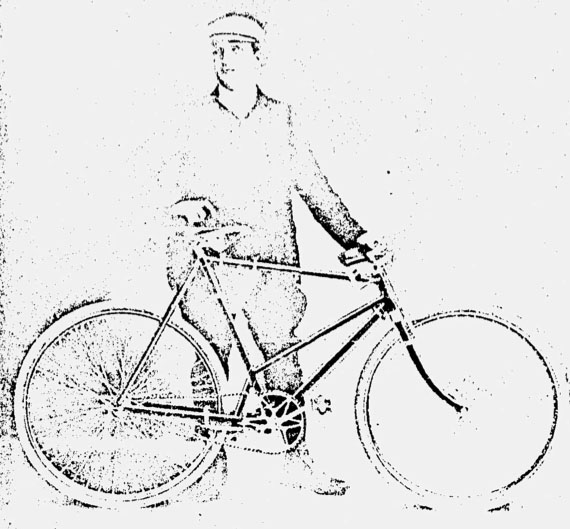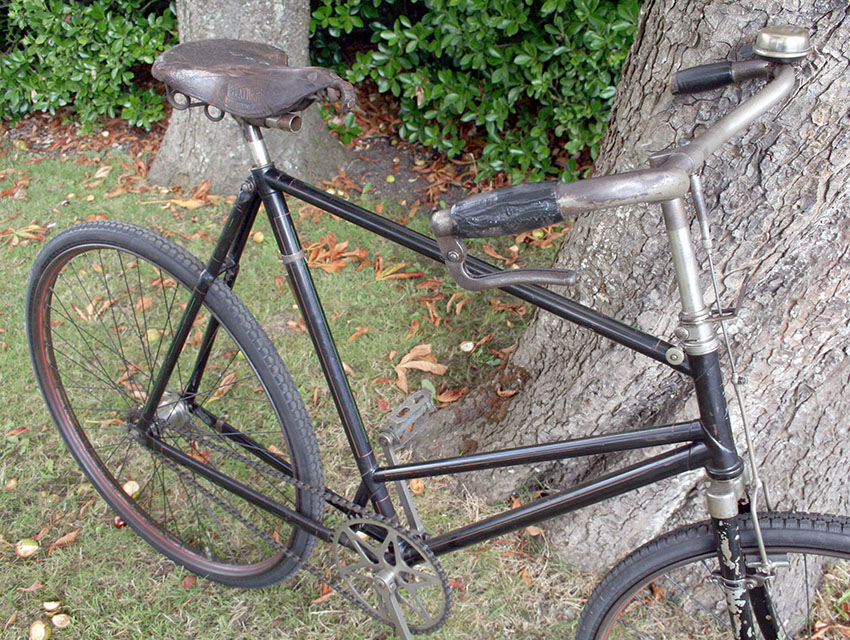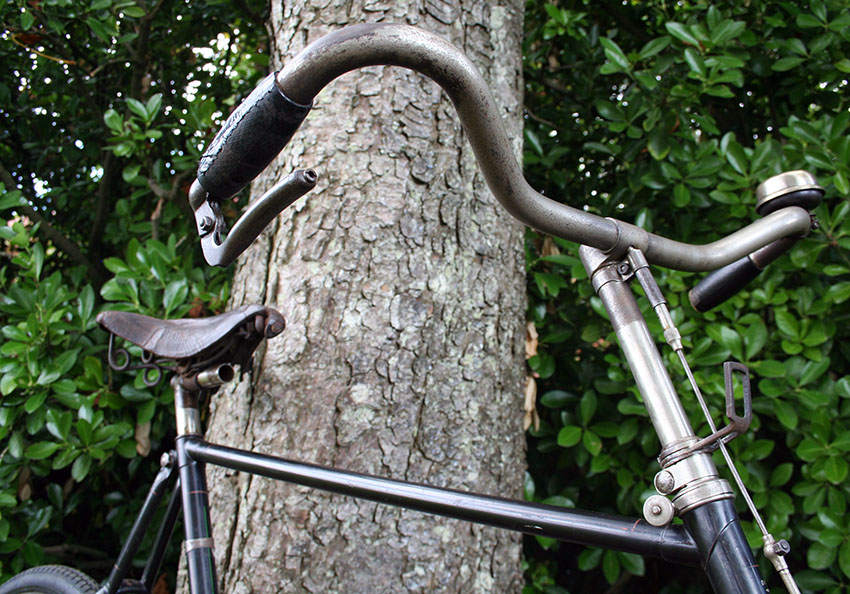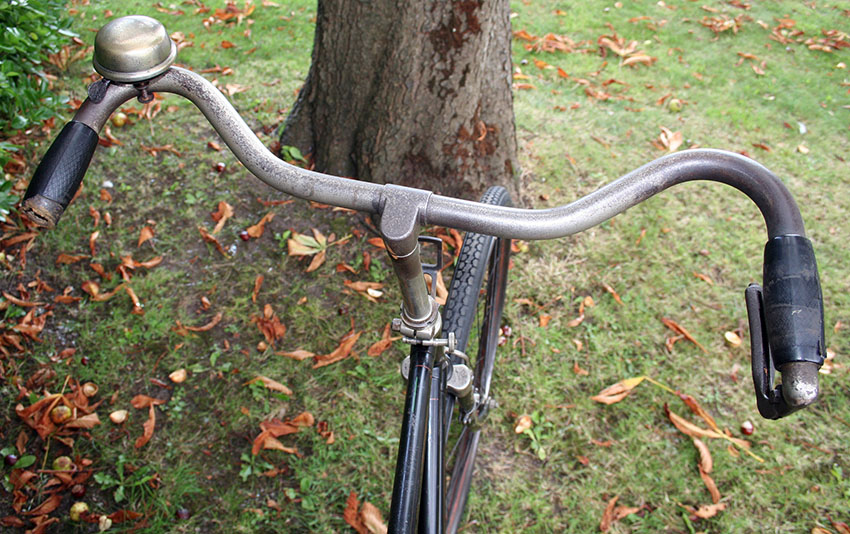

Easily recognised from a distance, after its introduction in 1901 the Royal Enfield Girder Frame became the company’s flagship model. It was used extensively in road racing.
The illustration below shows an identical 1905 Royal Enfield Road Racer with sloping top tube but updated with the company’s later chainwheel, handlebars and Lea Francis pedals. Owned by W. Gill, it featured prominently in Royal Enfield’s 1914 publicity campaign.


1905 Royal Enfield Girder Road Racer
Sloping Top Tube with 2 Inch Drop
Inverted Lever Cable-Operated Front Brake; Eadie Coaster Rear Brake
Embossed Leatheries ‘No 150’ Saddle
53-Tooth Racing Chainwheel
24″ Frame
28″ Wheels
Frame No 217235
(Now sold)


This machine was previously part of the collection of a long-time veteran cycle club member in the Midlands who specialised in early Royal Enfield and Eadie machines. Turn-of-the-century Girder Frame Royal Enfields are very scarce.
This top-quality racing machine is the first Sloping Top-Tube Girder Road Racer I’ve encountered. It may be the only survivor.
Though a 24 inch frame, it appears taller. The sloping top tube has a two inch drop, from 34″ to 32″ standover height.
The paintwork is original, unrestored, in very good condition, retaining most of its box-lining …or, as the catalogue would have it ‘handsomely lined in burnished gold.’ Even the wheels still have some of their lining.
Royal Enfield used a head transfer (decal) rather than a metal badge in 1905; the transfer on this example can be seen. The Royal Enfield name is not legible but the crown is apparent and when you compare it with the Royal Enfield logo seen on this page it is immediately identifiable.
The only negative issues I’ve found on this bike are: most of the original paint on the front forks has worn off; the original handlebar grip that houses the concealed brake cable is damaged (unavoidable if you need to replace the cable); pedals are rat traps but not original to the bike.
The chainwheel is a 53-tooth racing crank. It is imprinted ‘Enfield Cycle Co’ on both pedal cranks.
No records are held for Royal Enfield frame numbers; identification is done by studying the changes made each year: in this case, the head transfer appeared for two years only, between two different styles of headbadge; a coaster brake was fitted from 1903; roller lever brakes were introduced in 1906. By the way, the well-known ‘field gun’ style of chainwheel (and similar style lamp bracket) was not introduced until 1912.

As you can see on this model, the first Girder frames had one extra tube fitted between the seat tube and the chainstay bridge. The ‘Duplex’ Girder, which made its debut in 1907, featured twin extra tubes in an inverted V shape connecting to the chainstays.







The Model Riche Road Racer (below), fitted with two-speed gear, was the company’s top of the range machine, priced at 16 guineas against 12 guineas for the single-speed Girder.






1907 ROYAL ENFIELD CATALOGUE: HANDLEBAR OPTIONS


A point of interest on this machine is that the main 1907 catalogue picture (above) shows this model with dropped handlebars. As the Road racer was styled as closely as possible to the Royal Enfield Girder models actually used in racing, this no doubt made for a more dramatic picture; however, a steep drop plus racing handlebars made it more impractical to use the bike for daily commuting. Most customers would have bought such a machine for regular use during the week and amateur racing at weekends. So the catalogue illustration below it features upturned Royal Enfield ‘No 2’ handlebars …as fitted to this 1905 example.

It’s likely that the purchaser of this 1905 Road racer was tall, because the handlebars have a long stem, which has the effect of raising them to the height of a normal roadster.



Although the 1905 catalogue refers to the machine simply as the ‘Royal Enfield Road Racer,’ by 1907, with extra options available, this particular model with Eadie Coaster had been designated ‘Club Model, No 1010.’
There is no retained record of Royal Enfield frame numbers, which are not necessarily consecutive. So it’s not possible to calculate their age in that way: this can only be done by observing annual detail changes. The difference between 1905 and 1907 is that by 1907 a metal head badge was fitted (showing a field gun in the centre), whereas in 1905 the company used a head transfer (decal).












The Royal Enfield name is a British institution. Of course, these days, the company is India’s primary motorcycle manufacturer, so the name and its history has been wonderfully preserved. As The Enfield Cycle Co the company was important in the early years of cycle manufacture. In 1892 Eadie won a contract to supply rifle parts to the Royal Small Arms factory at Enfield and to celebrate this a new bicycle design was named the ‘Enfield’ from October that year. In 1893 ‘Royal’ was added (from the Royal Small Arms name) making the model name ‘Royal Enfield.’



















LEATHERIES EMBOSSED ‘MODEL 150’ LEATHER SADDLE






1912 ROYAL ENFIELD DUPLEX GIRDER LADY’S

TO SEE MORE OF THE
1912 ROYAL ENFIELD DUPLEX GIRDER LADY’S
PLEASE CLICK HERE




PHOTO LOCATION: Waldron, East Sussex
This 12th century village’s name is derived from the Anglo-Saxon ‘weald aern’ meaning ‘house in the wood. Presumably, the title of Henry David Thoreau’s 1854 book ‘Walden; or Life in the Woods’ has the same linguistic root:
I went to the woods because I wished to live deliberately, to front only the essential facts of life, and see if I could not learn what it had to teach, and not, when I came to die, discover that I had not lived.

































































